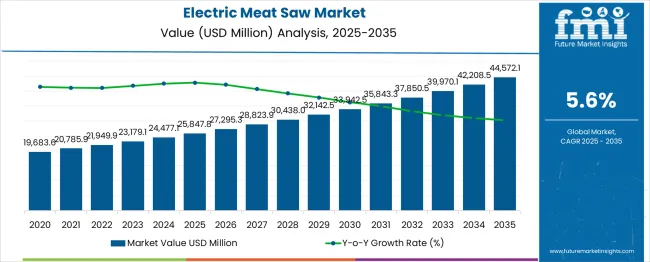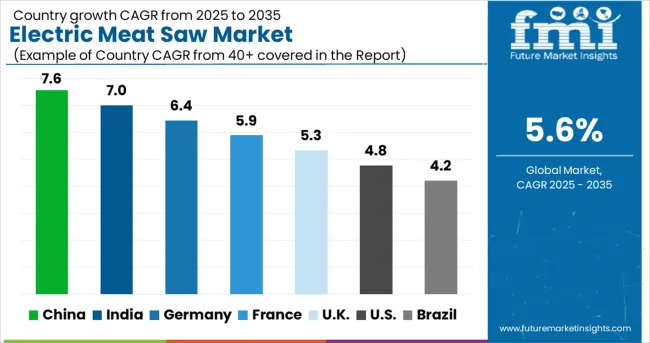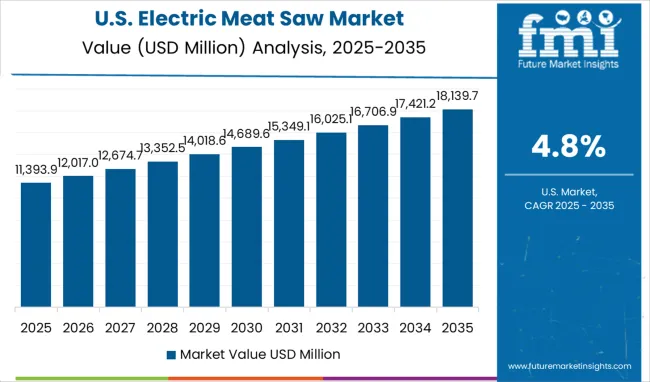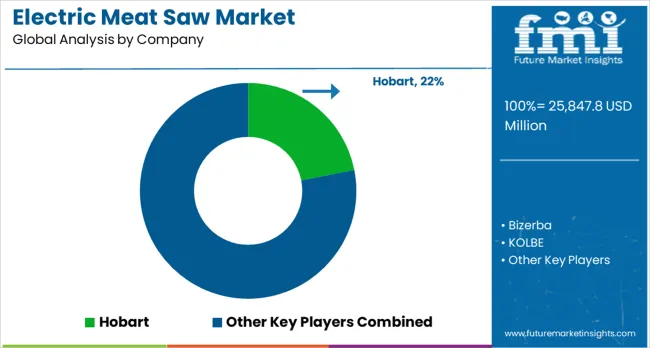The Electric Meat Saw Market is estimated to be valued at USD 25847.8 million in 2025 and is projected to reach USD 44572.1 million by 2035, registering a compound annual growth rate (CAGR) of 5.6% over the forecast period.

| Metric | Value |
|---|---|
| Electric Meat Saw Market Estimated Value in (2025 E) | USD 25847.8 million |
| Electric Meat Saw Market Forecast Value in (2035 F) | USD 44572.1 million |
| Forecast CAGR (2025 to 2035) | 5.6% |
As per Future Market Insights (FMI), over the past half-decade, the global electric meat saw market witnessed positive growth owing to the growing consumption of non-vegetarian food products across the globe.
According to the UN Food and Agriculture Organization, worldwide meat consumption will increase by more than 1% this year. The fastest growth will be in low- and middle-income countries with increasing meat demand in key meat-producing and exporting economies such as Brazil, China, and India. However, India as a country consumes the least amount of meat but is a major exporter of both meat products and equipment.
Sausages, slicers, hamburgers, and meatballs are just a few examples of processed meat products. The demand for freshly processed meat products is increasing as a result of highly processed dishes such as fried sausages, kebabs, and chicken nuggets.
Hence, surged availability of diverse meat products will increase overall meat consumption. This allows suppliers more opportunities to introduce new commercial electric meat saw models to the market.


Growing Consumption of Meat Products to Boost Electric Meat Saw Sales
According to FMI, sales of electric meat saws in the USA are projected to increase at 7.5% CAGR, accounting for over 71.2% of demand share in North America. Demand for electric meat saws is expected to increase with growing meat-consuming population and growing urbanization. In the USA, replacing or converting to new, more efficient equipment is quick, resulting in increased revenue.
China Electric Meat Saw Market to Benefit from Presence of Commercial Hotels and Slaughterhouses
With the presence of numerous hotels, restaurants, and slaughterhouses, China is considered as one the most lucrative markets for electric meat saws. Sales of electric meat saws are predicted to increase at a CAGR of 8.05% over the forecast period.
This is expected to pave the door for hotels and restaurants to adopt worldwide standard meat slaughtering.
Australia to be the Hotspot for Electric Meat Saw Manufacturers through 2025 & Beyond
The government in Australia is investing extensively into the meat export industry. Reduced regulatory costs and administrative burdens for meat and meat product producers and exporters are creating conducive environment for the Australia electric meat saw market.
As per the study, demand for electric meat saws in Australia is surging at a CAGR of 4.5%, with the market accounting for 62.5% of demand share through 2025.
Countertop Electric Meat Saws to be the Most Preferred Among Foodservice Enterprises
Countertop electric meat saws are expected to dominate the commercial electric meat saws market. Factors like the availability of commercial electric meat saws adapted to the needs of supermarkets and foodservice enterprises.
A countertop electric meat saw is a tiny, lightweight variant that may be used on a workbench or a countertop. It only has a small cutting area and isn't designed to butcher massive cuts of meat. Hence, a countertop electric saw is ideal for residential as well as commercial sectors.
Demand for Electric Meat Saw to Witness a Boom in Slaughterhouses Over the Forecast Period
According to Future Market Insights (FMI), the highest number of slaughterhouses are in China, the USA, and Brazil will fuel the growth in the market. Electric meat saws are becoming increasingly popular in the commercial sector.
This is due to the surge in the demand for processed and packaged foods. Electric meat saws are used to chop huge portions of meat into smaller, more manageable pieces that can be processed or cooked later.
They're also used to make delicacies like roast beef, ham, and turkey in restaurants and hotels. The increasing demand for processed meat products throughout the world has prompted commercial electric meat saw manufacturers to improve their designs to attract more clients.
Adoption of Semi-Automatic Electric Meat Saws to Burgeon Across Commercial Hotels and Restaurants
Since semi-automatic saws are less expensive and can be employed in emerging economies with minimal labour expenses. The saw machine is ideal for cutting meat, bones, poultry, and fish, as well as freezing them.
They're common in hotels, restaurants, food processing plants, and butcher shops. An operator starts the operation and the machine finishes it on semi-automatic equipment. With minimum user involvement, a completely automated system starts and concludes the procedure.

Key players are pursuing a variety of methods, including mergers and acquisitions. Furthermore, numerous significant firms are working on new product launches and development to expand their capacity and get a foothold in the business.
For Example,
| Attribute | Details |
|---|---|
| Forecast Period | 2025 to 2035 |
| Historical Data Available for | 2020 to 2024 |
| Market Analysis | USD Million for Value & Unit for Volume |
| Key Regions Covered | North America; Latin America; Europe; East Asia; South Asia; Oceania; Middle East & Africa |
| Key Countries Covered | The USA, Canada, Brazil, Mexico, Chile, Peru, Germany, The UK, France, Spain, Italy, BENELUX, Nordic, Poland, Russia, China, Japan, South Korea, India, Thailand, Indonesia, Malaysia, Singapore, Australia, New Zealand, South Africa, North Africa, GCC Countries |
| Key Segments Covered | Equipment Type, Sales Channel, Type, Power |
| Key Companies Profiled | Hobart; Bizerba; KOLBE; Skyfood Equipment; Minerva Omega Group; BIRO Manufacturing; Wedderburn; Sammic; Marel; Butcher Boy Machines International; Weston; Chbiao; Brice Australia; Others |
The global electric meat saw market is estimated to be valued at USD 25,847.8 million in 2025.
The market size for the electric meat saw market is projected to reach USD 44,572.1 million by 2035.
The electric meat saw market is expected to grow at a 5.6% CAGR between 2025 and 2035.
The key product types in electric meat saw market are floor-model and countertop.
In terms of sales channel, restaurant segment to command 34.9% share in the electric meat saw market in 2025.






Full Research Suite comprises of:
Market outlook & trends analysis
Interviews & case studies
Strategic recommendations
Vendor profiles & capabilities analysis
5-year forecasts
8 regions and 60+ country-level data splits
Market segment data splits
12 months of continuous data updates
DELIVERED AS:
PDF EXCEL ONLINE
Electric Aircraft Onboard Sensors Market Size and Share Forecast Outlook 2025 to 2035
Electrical Label Market Size and Share Forecast Outlook 2025 to 2035
Electric Round Sprinklers Market Size and Share Forecast Outlook 2025 to 2035
Electric Cloth Cutting Scissors Market Size and Share Forecast Outlook 2025 to 2035
Electrical Insulation Materials Market Size and Share Forecast Outlook 2025 to 2035
Electric Aircraft Sensors Market Size and Share Forecast Outlook 2025 to 2035
Electric Traction Motor Market Forecast Outlook 2025 to 2035
Electric Vehicle Sensor Market Forecast and Outlook 2025 to 2035
Electric Vehicle Motor Market Forecast and Outlook 2025 to 2035
Electric Off-Road ATVs & UTVs Market Size and Share Forecast Outlook 2025 to 2035
Electric Blind Rivet Gun Market Size and Share Forecast Outlook 2025 to 2035
Electric Fireplace Market Size and Share Forecast Outlook 2025 to 2035
Electric Glider Market Size and Share Forecast Outlook 2025 to 2035
Electric Vehicle Battery Conditioners Market Size and Share Forecast Outlook 2025 to 2035
Electric Power Steering Motors Market Size and Share Forecast Outlook 2025 to 2035
Electric Motor Market Size and Share Forecast Outlook 2025 to 2035
Electric Gripper Market Size and Share Forecast Outlook 2025 to 2035
Electric Boat Market Size and Share Forecast Outlook 2025 to 2035
Electric Bicycle Market Size and Share Forecast Outlook 2025 to 2035
Electric Vehicle Transmission Market Size and Share Forecast Outlook 2025 to 2035

Thank you!
You will receive an email from our Business Development Manager. Please be sure to check your SPAM/JUNK folder too.
Chat With
MaRIA